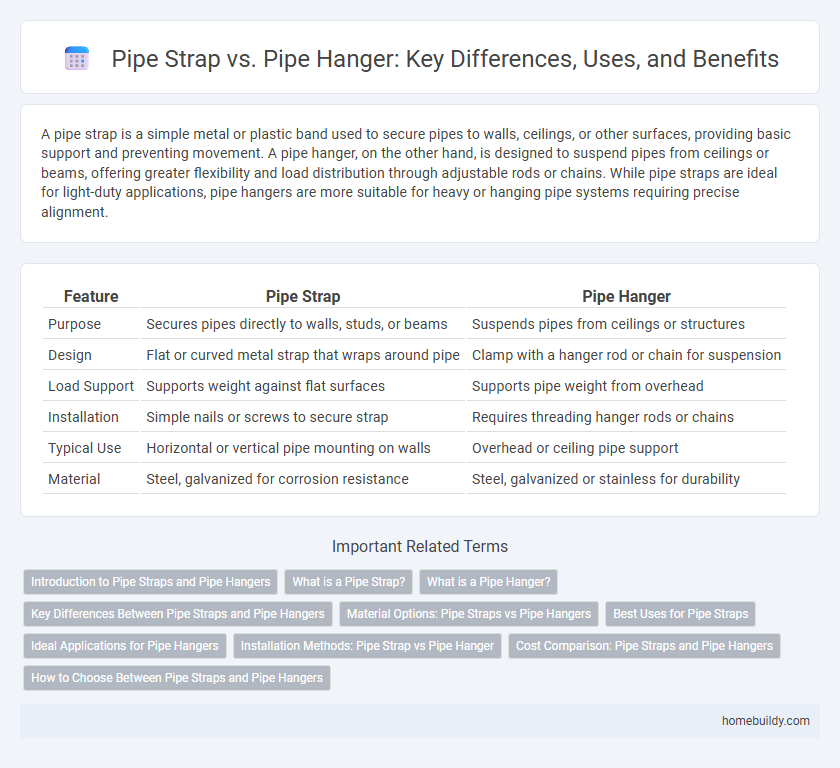A pipe strap is a simple metal or plastic band used to secure pipes to walls, ceilings, or other surfaces, providing basic support and preventing movement. A pipe hanger, on the other hand, is designed to suspend pipes from ceilings or beams, offering greater flexibility and load distribution through adjustable rods or chains. While pipe straps are ideal for light-duty applications, pipe hangers are more suitable for heavy or hanging pipe systems requiring precise alignment.
Table of Comparison
| Feature | Pipe Strap | Pipe Hanger |
|---|---|---|
| Purpose | Secures pipes directly to walls, studs, or beams | Suspends pipes from ceilings or structures |
| Design | Flat or curved metal strap that wraps around pipe | Clamp with a hanger rod or chain for suspension |
| Load Support | Supports weight against flat surfaces | Supports pipe weight from overhead |
| Installation | Simple nails or screws to secure strap | Requires threading hanger rods or chains |
| Typical Use | Horizontal or vertical pipe mounting on walls | Overhead or ceiling pipe support |
| Material | Steel, galvanized for corrosion resistance | Steel, galvanized or stainless for durability |
Introduction to Pipe Straps and Pipe Hangers
Pipe straps are metal or plastic fasteners designed to securely hold pipes against walls or ceilings, providing a simple and cost-effective support solution. Pipe hangers involve a more complex system with adjustable components that suspend pipes, allowing for better load distribution and flexibility in positioning. Choosing between pipe straps and pipe hangers depends on factors like pipe size, weight, and installation environment, with pipe straps suited for lighter applications and pipe hangers preferred for heavy-duty or adjustable support needs.
What is a Pipe Strap?
A pipe strap is a simple, durable fastening device used to secure pipes to walls, ceilings, or other structures, typically made of metal or plastic. Unlike pipe hangers that suspend pipes, pipe straps hold pipes firmly in place by wrapping around the pipe and anchoring it directly to the surface. This makes pipe straps ideal for stabilizing plumbing or electrical conduit runs where minimal movement is desired.
What is a Pipe Hanger?
A pipe hanger is a mechanical device designed to support and suspend pipes from ceilings, beams, or walls, ensuring proper alignment and reducing stress on the piping system. Unlike a pipe strap, which tightly wraps around the pipe to secure it close to the mounting surface, a pipe hanger typically includes adjustable components that allow for height variation and improved load distribution. This flexibility makes pipe hangers essential for accommodating thermal expansion and vibrations in plumbing, HVAC, and industrial piping installations.
Key Differences Between Pipe Straps and Pipe Hangers
Pipe straps are designed to securely fasten pipes against a surface, providing a simple and cost-effective solution primarily for horizontal runs. In contrast, pipe hangers support pipes by suspending them from ceilings or structures, allowing for vertical adjustment and reducing stress on the piping system. Key differences include load capacity, installation flexibility, and suitability for different pipe orientations and environments.
Material Options: Pipe Straps vs Pipe Hangers
Pipe straps are typically made from galvanized steel, stainless steel, or plastic materials, offering corrosion resistance and durability for securing pipes to walls or ceilings. Pipe hangers, on the other hand, often incorporate materials like stainless steel, carbon steel, or rubber-lined components to provide enhanced vibration damping and load distribution. The choice between pipe straps and pipe hangers depends on factors such as environmental conditions, load requirements, and the need for flexibility or insulation.
Best Uses for Pipe Straps
Pipe straps offer a secure and cost-effective solution for fastening pipes to walls or ceilings, ideal for straight runs where minimal movement is expected. They are best used in applications involving copper, PVC, or steel pipes that require rigid support without the need for adjustable or suspensive capabilities. Compared to pipe hangers, pipe straps provide simpler installation and support commonly found in plumbing and light-duty mechanical systems.
Ideal Applications for Pipe Hangers
Pipe hangers are ideal for suspending pipes in open spaces where vertical load support and adjustment flexibility are essential, making them suitable for HVAC, plumbing, and industrial systems with varying pipe diameters. They provide superior load distribution and vibration isolation compared to pipe straps, which are better suited for securing pipes to flat surfaces like walls or ceilings. In applications requiring frequent maintenance or movement of pipes, pipe hangers offer easier access and repositioning, enhancing system longevity and safety.
Installation Methods: Pipe Strap vs Pipe Hanger
Pipe straps secure pipes by wrapping around and fastening directly to a surface using screws or nails, offering a straightforward and quick installation process ideal for light to medium loads. Pipe hangers, in contrast, suspend pipes from ceilings or beams with adjustable brackets or clevis assemblies, providing flexibility for positioning and accommodating heavier loads or thermal expansion. Installation of pipe hangers requires more precision and support system integration, making them suitable for complex piping layouts where stability and load distribution are crucial.
Cost Comparison: Pipe Straps and Pipe Hangers
Pipe straps generally offer a more cost-effective solution compared to pipe hangers due to their simpler design and ease of installation. Pipe hangers, which often require additional components like rods and clamps, tend to increase overall project expenses, especially in large-scale plumbing or mechanical setups. When budgeting for pipe support systems, the upfront and labor costs associated with pipe straps often make them the preferred choice for budget-conscious projects.
How to Choose Between Pipe Straps and Pipe Hangers
Pipe straps provide a secure, low-profile solution for fastening pipes to flat surfaces, ideal for light to moderate load applications and easy installation. Pipe hangers offer superior support for heavier pipes or systems requiring suspension, allowing for vertical adjustment and vibration isolation. Choosing between pipe straps and pipe hangers depends on pipe weight, required support type, installation environment, and load-bearing needs.
Pipe strap vs Pipe hanger Infographic

 homebuildy.com
homebuildy.com